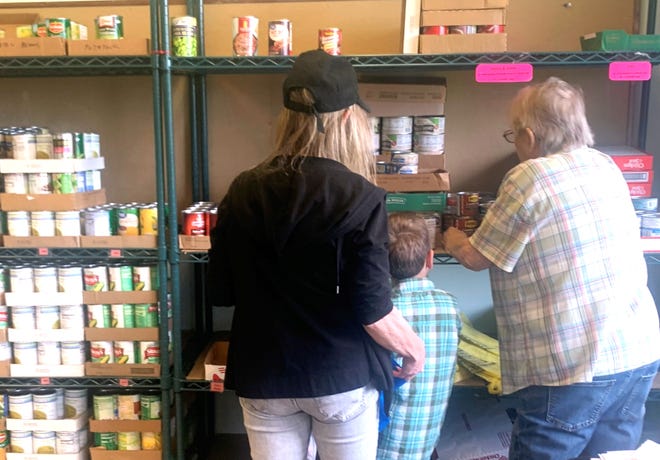In late 2023, when leaders at Centers Health Care, a network of skilled nursing, rehabilitation and senior care services, were deciding which organizations across New York state to support with donations, their pick in the Elmira-Corning area was the Food Bank of the Southern Tier.
And there's good reason for that.
The food bank, based in Elmira Heights, purchases food, collects donated food and distributes it to food pantries and soup kitchens across a six-county region.
Food bank officials say public demand for these supplies has skyrocketed in recent years.
In fact, more requests for food were filled in the first quarter of 2024 than any first quarter in the organization's 40-plus year history, according to food bank president and CEO Mark Bordeaux.
Food banks distributed a record 16.4 million pounds of food last year, and that record is already being broken.
“Right now, we're up 19% in the first quarter, from January through March, compared to the first quarter of 2023,” Bordeaux said. “At our current pace, we'll be (distributing) 1.4 million more pounds of food than we did last year.”
What is causing the increase in hunger issues in the Southern Tier?
Horseheads resident Amanda Stark is a regular at the food pantry at Horseheads First Presbyterian Church.
Stark said even if you have a job, it's often difficult to even put food on the table, especially if you have children.
“It's hard. I come here once a month,” she said. “I've been going for a while now. I'd struggle without it. I don't know what I'd do.”
With more and more people like Stark coming to the food pantry, it's hard to keep the shelves full, said co-director Cathy McNulty.
“We're seeing a clear spike in the number of families we're seeing every week,” McNulty said. “Families are telling us how hard it is for them to pay the bills, especially if they have children.”
“We want people to know that we're so grateful to have them here,” she said, “and if they're not, we don't know how to fill that gap.”
McNulty said inflation and rising prices for food, gasoline and just about everything else is likely causing the increased demand for food, and Bordeaux agreed.
“There's a confluence of factors — inflation, food costs, housing costs, current car ownership, interest rates,” he said. “Insurance premiums are going up. Salaries are not keeping up with the cost of living.”
“We're here to support the community,” Bordeaux said. “The goal is to help and assist people in the short term. They have to make a choice.”
Community support for food banks is crucial
Just as food banks exist to support their communities, they need support from the community, both financially and through volunteerism, to carry out their mission.
Southern Tier Food Bank has an annual budget of about $24 million, with donations from individuals and corporate partners covering about 50% of operating costs.
This is in addition to approximately 14,000 hours of unpaid service provided by volunteers each year.
“We are so blessed by the community we live in. They have supported us time and time again,” Bordeaux said. “Volunteers come out and donate their valuable time and funds, and we are fortunate to have so many corporate partners who support us year after year.”
Centers Health Care, which has facilities in Corning and Bath, is one of this year's corporate donors.
To celebrate its 27th anniversary, the group donated $2,700 each to various organizations across the state.
The Food Bank of the Southern Tier was one of the beneficiaries of that aid.
“We're very proud to be able to donate to this amazing food bank,” said Shannon Robertson, Corning Center recreation director, “We know they're always looking for donations and it's really amazing what they do for people in Elmira and throughout the Southern Tier.”
How Southern Tier food banks plan to meet growing need
Food banks have several strategies to address the increased demand for food services.
The three key areas include food recovery, a focus on nutritious foods, and the strategic expansion of some programs.
“We're increasingly focusing on food recovery and trying to minimize waste,” Bordeaux said, noting that the food bank works closely with area grocery retailers such as Walmart, Wegmans and Weis Markets to reduce food waste.
The food bank has created new positions to make the most of these efforts, and through March, it had collected 133% more food than the same period last year.
The food bank's service area includes Broome, Chemung, Schuyler, Steuben, Tioga and Tompkins counties and covers approximately 4,000 square miles.
“We've been working hard to look at where the hunger is, where we can best serve and expand our programs,” Bordeaux added. “Where are the gaps that need to be filled?”
Local, newly accredited Waverly Birthing Center combines the comfort of home with medical precision
For those looking to support the food bank, Bordeaux said the best way to do so is through monetary donations.
“We welcome food donations, but if you donate money we will match it three times as much,” he said.
While the food bank is meeting demand for now, Bordeaux acknowledged there is a lot of uncertainty about the future.
“The community helps out every year, but how much longer can they continue to help if the demand continues,” he asked. “We have some reserves, but it's not for the long term. We don't know what the future holds.”
For more information, visit foodbankst.org.
Follow Jeff Murray on Twitter SG Jeff MurrayFor unlimited access to breaking news, subscribe now or activate your digital account.






